This week I’d like to feature the oversized magazine/book entitled; The Steranko History Of Comics. It was published in 1970 by Supergraphics, i.e. Jim Steranko himself. While researching this item on the internet, I’ve discovered my cover is actually a second printing, rather than the first printing I thought it was. This was determined by the address listed in the indicia page, but you probably don’t really care, so I’ll move on. The book is not truly a history of comics, as it just covers the beginning of the industry, and just covers early comics, but it still well worth owning, even today.
It was the first issue of a planned series. I’m not sure how many issues were planned, but only two saw the light of day. Here’s the cover that was shown in adverts for it back in the day. I ordered mine from Supergraphics and I never saw it sold in stores, but that doesn’t mean that it wasn’t, I just never encountered it in shops. But then again I wasn’t buying comics regularly in 1970, as I had a two or three year break about then.
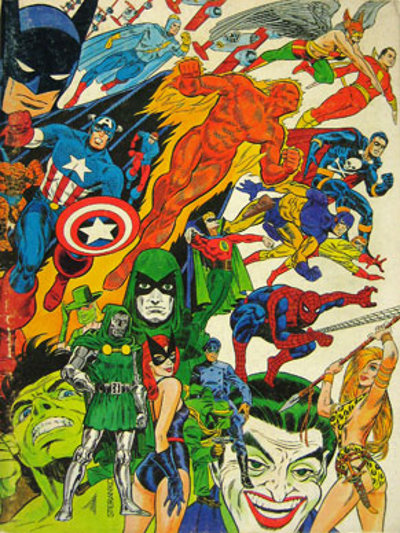
The Steranko History of Comics # 1 front cover
The actual cover was done as a full wrap-around cover, so I better give you the full picture, as well, eh? Well, here ya go:
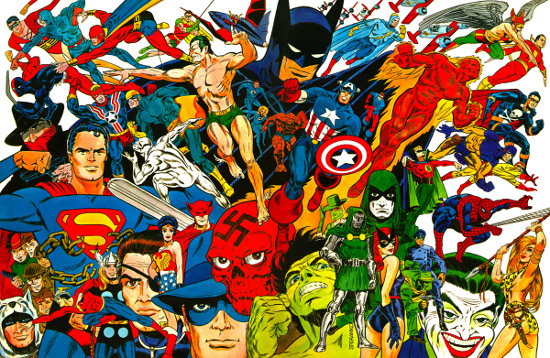
The Steranko History of Comics full wrap around cover
Now that’s a cover that is pure art. Sterank included many heroes and villains, as you can see. Though he does included quite a few that are not covered with the book itself, so I would guess that the cover represents Jim’s favorite characters, or at least the ones he liked to draw the best. Does anyone know if Steranko ever offered it as a print? It would be well worth owning and framing, as it’s just gorgeous!
The book/magazine opens with an introduction from well known film director, Federico Fellini. Also on this page is a nice Alex Raymond illustration of Flash Gordon and Ming the Merciless sword fighting.
The first chapter is entitled; Coming Attractions, and Steranko starts his comic book history back between 40,000 and 5,000 B.C.. Yes, you read that right, as he talks about pre-historic cave drawings. Think about it, those drawings really were comic strip art as they strived to tell a story with pictures. He then quickly moved through history until he reached the early 1900s and the beginning of the comic strips in newspapers, strips like the Yellow Kid, the Katzenjammer Kids, Hay Hooligan, Mutt and Jeff. He also covered Krazy Kat and Little Nemo in Slumberland, two of my favorite early strips. Next up was Tarzan of the Apes, Dick Tracy, Buck Rogers, Alley Oop, Terry & the Pirates, Flash Gordon and Prince Valiant.
This chapter was illustrated by full page comic strip reprints of Prince Valiant, Flash Gordon, Terry & the Pirates and Tarzan. All this in just the first chapter!
The second chapter was entitled; The Bloody Pulps. And as you might suspect, Steranko lovingly discusses The Shadow, The Spider, Doc Savage, Secret Agent X, G-* and his Battle Aces, Weird Tales , Planet Stories and many, many more . This chapter features many covers of popular pulps, as well as, full page artwork the Black Bat and also the Amazing Stories pulp that first featured a Buck Rogers story.
Chapter 3 is all about Superman, entitled; The Super Star, the character that began what we know as comic books today. The chapter leads off with a full page reprint of Joe Shuster‘s first Superman drawing and goes on from there. Steranko also reprints four pages from an unpublished Superman story from 1939. He provides many cover pics, including Action Comics # 1 and Superman # 1 from 1938 and 1939. Full pages in this chapter feature the first Superman newspaper comic strips an a page of Joe Shuster’s layouts.
Chapter 4 features Batman, as well as, his junior crime-fighting ward, Robin. It’s entitled; The Playboy Hero and leads off with a large unpublished Batman and Robin illustration by his creator, Bob Kane with inks by Jerry Robinson. Steranko starts right at Detective Comics # 27, with stops at Detective Comics # 33, which contained Batman’s origin story. Along the way he covers Batman # 1, as well. He reprints many covers in this chapter, as well, and discusses the Batman comics up through the 1950s.
Chapter 5 switches from DC Comics, over to Atlas Comics, which would later become Marvel Comics. And this chapter covers Captain America, the patriotic hero created by Joe Simon and Jack Kirby. It’s entitled; The American Idol and this chapter leads off with a dynamic full pager by Kirby, take a look:
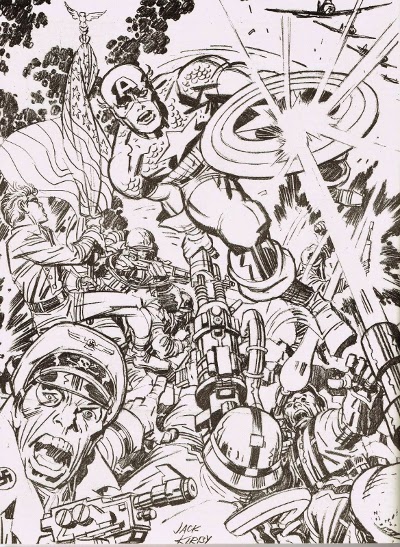
Captain America by Jack Kirby
Again Steranko covers the character from his beginnings up through the 1950s. As always he provides many cover reproductions. This is a shorter chapter, but does also include a second full page Captain America illustration by Jack Kirby.
Chapter 6 stays with Atlas Comics and features The Human Torch and Sub-Mariner. This chapter too has a great full page illustration done by Bill Everett. I’d be remiss if I didn’t share this wonderful art with you:
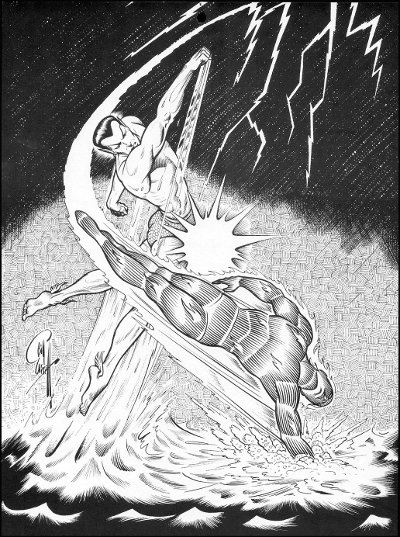
Sub-Mariner vs the Torch by Bill Everett
This just might be the greatest drawing of the Sub-Mariner and the Torch ever done! I really can’t say enough about this page. Marvelous, beautiful, exquisite, and a whole bunch more adjectives! Oh, the chapter is entitled; Super Double Feature, if you want to know. Steranko covers the first Atlas/Marvel comic, Marvel Comics, which featured the Torch’s origin story, of course. And he goes on to discuss other Marvel Mystery Comics, the Human Torch and the Sub-Mariner books. He also includes in this chapter the early Atlas/Marvel team-up book, All Winners Comics, as well as comics like, USA, Miss America, Select Comics and even the Blonde Phantom.
Chapter 7 jumps back to DC Comics and is entitled; Best Supporting Characters. Here’s the full page art that opens this chapter, it features the Justice Society of America and is drawn by Joe Kubert.
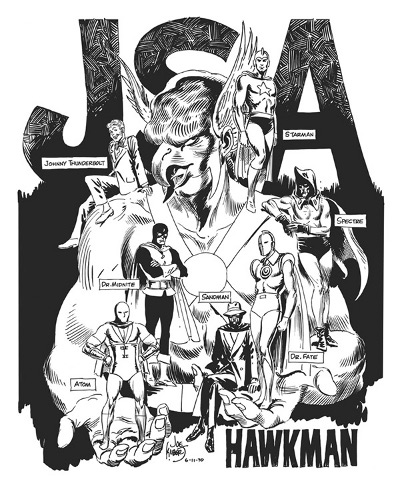
The JSA by Joe Kubert
In this chapter, Steranko covers the other big comics they published during the 40s and 50s. Comics like; World’s Finest, Flash Comics, Adventure Comics, Green Lantern, Sensation Comics, Wonder Woman and All Star Comics, to just name a few.
The final chapter in this book, chapter 8, is entitled; The Kid Players and as previously, it features plenty of reprinted comic book covers. Comics covered in this chapter include Young Allies by Atlas/Marvel, Star Spangled Comics, featuring the Newsboy Legion from DC Comics, Boy Commandos, also from DC Comics. As you can tell the team of Simon and Kirby rule this chapter and genre. The chapter features two really nice full page illustrations by Simon & Kirby.
Eighty-four (84) pages not including the wrap-around cover. Short by many standards but packed with tons of information. And in 1970, not a lot of this information was available to early comic book collectors. I found it wonderful reading, as well as, an informational goldmine and the artwork and reprinted covers were just icing on the cake!
Today there have been a lot of books written about the early beginnings of the comic book industry, but this two volume set is still well worth your collector’s money. So don’t hesitate to pick up both issues if you get the chance. I’ll plan on covering the second issue in the next Fabulous Find, unless I get a better idea or someone offers me huge sums of cash to cover something else, but the odds of that are slim to none!
Thanks for stopping by and please come back next week for a new RETRO REVIEW.
SUmmer is almost here, enjoy!









Many of the full page spreads done especially for the two volumes of the History of Comics had layouts provided to the artists by Jim Steranko.
I did not know that Tony! Thanks for sharing your knowledge, much appreciated!
Both volumes are a must for comic book lovers. I just picked up vol. 2 from Steranko himself, at a con he attended (unfortunately, he didn’t have vol.1). I owned them years ago, but both were lost in a flood (:-( I really love your breakdown of vol.1. Again, a must for those that love the history of comic books.
Thanks for stopping by and leaving your comment, Doug. I always appreciate hearing from those that read my posts. And I heartily agree with you, the two volumes are a must own for any true comic book fan who is interested in the history of our great hobby!
I got both volumes way back in the day and they opened so much to me that I didn’t know. That section on the Pulps was phenomenal! Both volumes are essential to comic book fans that’s for sure.
As Robert And Doug both say, these two oversize paperback books are a must for anyone’s collection if they want to know more about the early days of heroes in comic books!
A couple of notes, here:
I first read this not long after it’s publication, because a friend of mine gave me one. (B-Day gift):
I was very happy to learn, from it, how Bob Kane, then teenager, created Batman in 1939. However, I now know that the real work was done by (the often uncredited) Bill Finger, who worked on many comics, over the years. Kane had a rich uncle lawyer- and you can guess the rest.
Now, didn’t Steranko, industry ‘insider’ know about this?
Well, yes. In his later years Steranko has traveled to conventions, and basically corrected himself, telling the real story.
You see, at the time, I figure the author was starting out- after working for a while for Marvel comics. I guess he needed to sell a book, get started in the publishing game, and maybe avoid offending others in the comic industry. So the books, part I and II fudge a few things, here and there.
I still very much credit Steranko. I believe (and please correct me if I am wrong) that this is the very FIRST time anyone actually wrote any history of the comics- and it’s from a pro in the field.
At one point, he confronted Kane at a convention. Obviously, this was when they were both in retirement age. Steranko ‘bitch slapped’ Kane. And for good reason, I think.
To clarify the story, Steranko is as fascnating in person, as a public speaker, as he was in the comic pages. You won’t understand it, until you look for it on YouTube. (The closest comparison, is the way that Harlan Ellison, bless his soul, could captivate an audience.)
Born in 1938, he missed the great depression, however had a rough life. For a time, he stole coal, to get by. Like Ellison, he often locked horns with his dad. Eventually, leaving home, he joined the carnival circuit, or circus, and learned stage magic. He worked as an escape artist, as well, and a magazine art director. He did a stint as a male model (see pictures of how he looks). As with so many big talents, he left employment from the comic publishers, to go out on his own. Few people realize that he designed the Indiana Jones costume. That is, depending on how accurate my information is.
One of my points is that the surrounding story tells as much about the comic industry, as any specific publication history. Another one is that ‘time will tell.’ The later stages in life should be a time of reflection and clarification. And if possible- try to seek out comic talents from the past, who have created the industry today. They have a limited time to tell the story straight.
Nathan, thanks for stopping by and leaving such great comments. In regards to Jim Steranko. I’ve met him a couple of times and have had a chance to listen to him and even chat for a few minutes. A very interesting man with strong views!
I am aware of the Bob Kane stories and it just wasn’t the place to write about them in reviewing the first issue of Jim’s History of Comics, so I didn’t. Sorry if that marred your enjoyment of my review.
I really don’t think Jim’s history was the first, by any means, but definitely the first by a comic book “insider”, for sure.
When I first read Steranko’s History of Comics, I gathered enough from it to realize that Finger was, for most intents and purposes, the real creator of the Batman.
Daniel Kian McKiernan Yes, Steranko really “told it like it was”, so to speak. His two volume History of Comics really were awesome books at the time. There was very little written about the history and people behind the comics at the time. I think he really opened up a lot of eyes belonging to us fans!